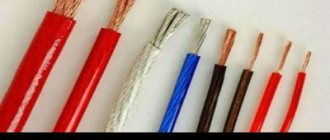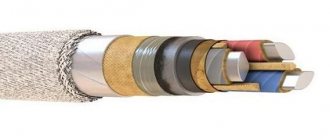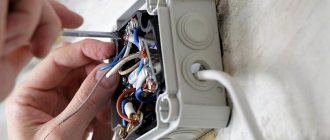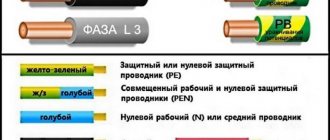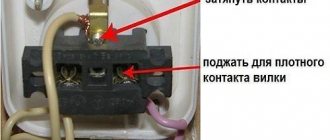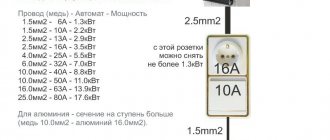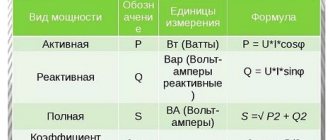To ensure uninterrupted operation of electrical equipment during various types of household, construction and repair work, it is necessary to ensure high-quality transmission of electricity over a distance. The easiest and most reliable way to do this is to make a special carrier. Let's look at what parameters an extension cable should have, what brands of conductor are most often used, what rules are used to select it for specific application conditions, and how to correctly calculate the possible power loss.
Cable for making an extension cord with PVC sheath Source prom.st
Popular cable brands - features, characteristics, application
For everyday use at home, the carrying cable must first of all have good flexibility, be resistant to low temperatures and frequent kinks. The following most popular range of conductor brands has similar characteristics:
- KG.
The marking abbreviation means flexible cable. Has a rubber electrical insulating shell. Performance characteristics:
- Operating temperature range – from -40 to +50°C.
- Number of bending cycles – 30 thousand.
- Service life – 4 years.
Designed for outdoor use. Compressive and bending loads are allowed. Exposure to direct sunlight is not recommended. The 220V extension cable has an analogue from European manufacturers - XYMM.
- KG-HL.
An analogue of the above brand of cable, but capable of operation at lower temperatures – down to -60°C. A distinctive feature is the ability to maintain elasticity in severe frost with full preservation of electrical characteristics.
For outdoor use, a cable with rubber insulation of the KGHL brand is best suited Source korona42.ru
- KGN.
The conductor is intended for use in aggressive conditions - when the shell can be exposed to various chemicals, oils, sparks from electric welding, etc. Operating parameters:
- Temperature – from -30 to +50 °C.
- Service life – 2.5 years.
- Number of bending cycles – 30 thousand.
The cable is also not recommended for use in direct sunlight.
- PVS.
This brand provides an answer to the pressing question of which wire is best to choose when the extension cord is inevitably operated under direct scorching rays of the sun. However, the price for such an advantage is an inevitable decrease in resistance to temperature changes.
Therefore, PVA can be used no lower than -25 °C, and ideally only at above-zero ambient temperatures. Its service life is about 6 years, and the number of bending cycles is 30 thousand.
- PRS
Another conductor based on a polyvinyl chloride sheath. Its characteristics are similar to PVA. The exception is a more extended temperature regime - from -40 to +40 °C. At the same time, European manufacturers have an analogue of this brand - this is RN.
Cable structure with PVC sheath brand PRS Source n-kabel.ru
Note! The longer the extension cord, the greater the power loss. The disadvantage is compensated by choosing a conductor with a larger cross-sectional area.
See also: Catalog of companies that specialize in electrical work of any complexity
Principle of operation
The principle of operation of an extension cord for a lawn mower for the end user is not much different from the mechanism of operation of an ordinary network carrier: the device is plugged into an outlet, transferred to the required distance (unwound to the required length), where a device is connected to it, in this case a lawn mower.
According to their design, extension cords for lawn mowers are classified into products “in a coil” and “on a reel”. The second option is the most popular and preferred.
In turn, extension cords on a reel are also classified into 2 groups . Representatives of the first category have the form of a coiled extension cable, one end of which is equipped with a molded socket. The coil and plug are located at the other end, located at the point of connection to a stationary outlet.
Extension cord on reel
This design is very convenient to use - the user does not need to carry the coil itself, just unwind the wire. Thanks to the special features of the case, unwinding and rewinding the cable is done quickly and without unnecessary effort.
The second type of reel extension cord is noticeably different from the model discussed above: here the reel is equipped with several sockets , allowing you to simultaneously connect more than one device.
Metal and plastic can be used to make coils. The first option is more preferable and is characterized by improved durability and resistance to adverse external influences.
How the device works
For use in conjunction with electric lawn mowers Alco, Gardena, Stiga, Bosch Rotak 32, Shtil, Makita, Champion, reel extension cords of the first group are best suited, because In accordance with safety precautions, it is strongly recommended not to take the coil far from a stationary outlet.
Along with this, models made in a waterproof housing are available for sale - if possible, use just such an extension cord for a reel-to-reel lawn mower.
Criterias of choice
When selecting a conductor for carrying in specific application conditions, it is necessary to consider the following number of parameters:
- Length and number of sockets.
- Brand and cross-sectional area.
- Protection from damage.
- Plug type.
- Protection from power surges and external conditions.
Let's look at the features of each of them in more detail.
Length
Sometimes the consumer does not understand the essence of the laws of functioning of electrical conductors and tries to decide which cable to choose for a 220 V extension cord for 50 meters and further - in this way, hoping to provide power to the most remote corner of his home area. In practice, this results in a huge loss of power, overheating and even the possibility of insulation fire.
The optimal length of a household electrical extension cord is 5-10 meters Source yato-shop.pl
The reason for this is the neglect of the rules for calculating the cross-section of the conductor in terms of its length. Therefore, in order to avoid various kinds of troubles and dangers in operation with electrical wiring, it is recommended to limit the carrying length to a maximum of 10 m. This is especially true when powerful electrical appliances are connected to the network.
In any case, the maximum permissible load on an extension cord in everyday life is limited to 3.5 kW or 16 A, respectively. At the same time, it will not be possible to increase the load by increasing the thickness of the conductor due to the limited endurance of the contacts in the outlet itself.
Recommendation! The number of sockets on the carrier can be 3, 5 or more. However, this does not mean that all of them can be connected at the same time. This was done primarily in order to protect the sockets from loosening when it is necessary to frequently switch different devices.
Brand and cross-sectional area
When choosing a conductor based on cross-sectional area, you must be guided by the following load recommendations:
- No more than 1.3 kW or 6 A – from 0.75 mm².
- Up to 2 - 2.5 kW or 10 A - at least 1-1.5 mm².
- Up to 3.5 kW or 16 A – 2.5 mm².
An extension cord may have a large number of contacts, but this does not mean that all of them can be connected at the same time. Source obi.ru
The most commonly used brands are PVS. However, if you need to use a carrier outdoors, in a garage or on a concrete or cluttered floor, it is better to give preference to the KG. Since the material of its shell is more resistant to destructive factors.
How to assemble an extension cord yourself
An electrical extension cord is designed to supply power to electrical appliances that are remote from outlets. There are a huge number of carriers on sale, which differ in the cross-section and length of the cable used. But by assembling the extension cord yourself, you can get a reliable, high-quality and safe device. In this case, the required carrying length is selected, which will avoid the problem of insufficient or excess wires.
To make an extension cord with your own hands, you will need to prepare:
- cable;
- socket block;
- collapsible fork.
Materials and tools for assembling the extension cord
You will also need to have a minimum set of tools. It takes about twenty minutes to assemble the carrier. The following is a step-by-step instruction for the process of making an extension cord:
- At the first stage, the upper protective sheath of the cable is removed, approximately five centimeters.
- Subsequently, one centimeter of the insulating layer is removed from the ends of each individual conductor.
- The prepared wires are connected on one side to the terminals of the extension cord socket, and on the other to the plug. In this case, it is necessary to ensure good contact by tightly tightening the terminals, as well as fixing the wire in insulation with a special clamp inside the plug. Otherwise, the contact part heats up and breaks down over time.
- Check the carrier for breaks using a multimeter.
- Reinstall the protective covers of the plug and extension cord, securing them with fasteners.
When making a carrier longer than twenty meters, you should use a reel for winding the cable line.
Calculation of power loss
In order to understand which wire to make an extension cord for the street from, you need to take into account the following number of parameters:
- Conductor material.
- The power of the consumer and the cross-sectional area depending on it.
- Carrying length.
With this data, you can determine power loss and risk factors for each specific extension cord. Let's look at an example calculation for a copper wire 5 m long and a cross-sectional area of 1.5 mm² using the following algorithm:
- Each meter of copper conductor has a resistance of about 0.01 ohms.
- When calculating, double the cable length (phase + zero) is taken - that is, 10 m.
- Thus, the total carrying resistance = 10 * 0.01 = 0.1 Ohm.
- When a current of 10 A is applied, the voltage drop = 10 * 0.1 = 1 V.
- In this case, the heating power of the conductor = 10 A * 1 V = 10 W.
When the carrying length increases to 10 meters, its value will increase to 20 W, and to 20 m - 40 W, etc. For an aluminum conductor, the heating value will be 1.5 times higher, which may already be sufficient to ignite the insulation. Therefore, it is extremely important to choose the right wire according to the material and the planned carrying length, and not just based on its cross-sectional area.
Plot size
The choice must begin with determining the mowing area. The extension cord should be long enough to easily reach the most remote places.
Try to estimate the distance by eye, and if in doubt, walk around the area, measuring the length with a rope. Add an extra 5 meters to the measurement results to perform maneuvers and overcome obstacles. Remember the result. Round up to standard cable sizes (eg 20, 40 or 60 meters).
Briefly about the main thing
Most often, for the manufacture of street extension cords, rubber-insulated conductors KG and its European analogue XYMM, KG-HL, KGN and cables with a polyvinyl chloride sheath PVA and PRS are used. Each of them has its own operating characteristics and recommendations for use.
When choosing a carrier, the following number of parameters are taken into account:
- Length and number of sockets.
- Brand, conductor cross-section.
- Protection from destruction.
- Fork modification.
- Resistance to external conditions and network fluctuations.
When selecting a conductor for the manufacture of an extension cord, it is necessary to determine its power loss and the risk factor for the sheath fire from possible heating.
Plug connection elements
The extension cord outlet must:
- Comply with European standard and plug with 5mm pins,
- be cast, rubberized, preferably with a higher protection class (for example, IP44).
The cord must end in a single socket, otherwise it will be awkward to drag across the grass.
It is necessary to choose extension cord models with “grounding”. Budget options without “ground” contact are dangerous to use for mowing wet grass. The extension cord plug is inserted into a grounded household outlet.
User manual
If you wish, you can permanently fix the extension cord before use - for this purpose, the coil design is equipped with two mounting holes.
Purchasing a chainsaw is quite a difficult task, because choosing among the numerous variations of offers is not easy even for a professional. The Carver chainsaw is quality, reliability at an affordable price.
There is no longer such a stylish and attractive tractor as the MAZ-541, which “lived” only in airports, and the number of produced MAZs of this model is only 3 pieces. By clicking on the link you will learn a lot of interesting things about this special airfield tractor.
Using a cultivator, you can easily and quickly plant various crops in the ground, as well as carry out various other procedures. Here you can get acquainted with the Patriot cultivator.
Install the reel in a suitable location, mark the locations of the future fasteners through the holes, drill recesses and secure the extension drum with bolts or other suitable fasteners.
To turn on the extension cord, you must connect its plug to a fixed power outlet. The automatic reel has an automatic expansion-retraction function. Unwind the cable to the desired length. After each half turn of the cord, its fixation is ensured.
To roll the cable after use, pull the cable until it is secure and then roll the cable slowly.
Automatic reels are characterized by a high traction force. Do not allow the cable to curl uncontrollably. Hold its end and slowly guide it along the movement of the automatic reel.
The reels of modern garden extension cords are equipped with mechanisms that provide protection against overheating during operation. As a rule, the color indication is the same in different models. So, if the LED glows red, this indicates that the overheating protection is on.
When the mentioned protective system is triggered, the light will go out. In such a situation, the user must unplug the extension cord from the network. After a few minutes (when the extension cord has cooled down), you can try to turn on the device again.
Reel lawn mower extensions do not require specialized maintenance . You just need to clean them periodically. The automatic coil must not be energized during cleaning. To comply with this rule, remove the extension cord plug from the fixed outlet.
Cleaning the outside of the extension cord is done with an ordinary dry and clean cloth. Make sure that no moisture gets into the structure of the extension cord.
When operating the extension cord, observe basic safety regulations and precautions:
- do not disassemble the extension cord;
- do not use the product in rainy weather;
- Do not use the extension cord in areas with excessive humidity ;
- do not allow moisture to get inside the extension cord structure;
- do not use the extension cord in places with increased dust, vibration, etc.;
- do not short-circuit the socket terminals;
- do not let children use an extension cord;
- Do not connect devices to the extension cord whose total power exceeds the maximum permissible for this device.
Now you know what a lawn mower extension is, how to choose it and use it correctly. Follow the recommendations received, and everything will go well.
What if I have three-phase power?
In this case, the task is simplified. If you connect three phases, the entire load will be distributed between them. Accordingly, you will need a five-core cable with a cross-section of 2.5 mm2 - as a rule, this is sufficient. Such a cable is still expensive and quite thick, but it is more convenient to work with 2.5 mm2 cores than with 4 or 6 mm2.
What type of cable should I take? The best options, in our opinion, are VVGng-Ls or NYM cables. These cables have self-extinguishing insulation, and their core cross-section corresponds to the norm (not like PUNP, where the cross-section can deviate from the norm by 30%).
Which cable should I use to connect an electric boiler?
Single-circuit or double-circuit boilers can have a power from 3 to 12 kW. Depending on the power, the appropriate wiring cross-section is selected. The table below shows the correspondence of the wire cross-section to the rated load it can withstand.
However, it is worth considering that, starting from 8 kW, three phases are needed to connect the boiler. For a three-phase connection you need to take VVGng-Ls 4*2.5 mm2 or NYM of the same cross-section. A separate machine is also installed for the electric boiler.
Security measures
When using an extension cord, the following precautions must be observed:
- do not allow use with an electrical load higher than permissible;
- avoid getting water inside;
- monitor the integrity and serviceability of plugs, sockets and cords;
- repairs can only be made when switched off;
- Do not lay the wire under carpets, wallpaper, or through door thresholds;
- Do not twist or bend the cord.
With your own hands you can make a reliable and convenient extension cord that will meet your requirements and cost less than a ready-made analogue.
Electrical parameters and ratings of circuit breakers
As we found out, there should be separate RCDs and a circuit breaker in the electrical panel. Through them the phase is supplied to the socket. This pair can be replaced with a difavtomat. These are the same two devices, but in one case. The negative is taken from the common bus, passes through the RCD, and the grounding is taken from the corresponding bus.
The rating of the machine is selected based on the maximum current consumption. This data is in the electric stove's passport and is usually in the range of 40-50 A. In this range, the ratings come in large increments - 40 A, 50 A, 63 A. It is better to choose the nearest larger one - this way there is less chance of a false shutdown when operating at full power . That is, if the declared maximum current consumption is 42-43 A, still take a 50 A machine.
Electric stove connection diagram
On the other hand, you may never turn on all the burners and oven, and even at full power, and more powerful machines are significantly more expensive. It's up to you to choose.
The rating of the RCD is taken one step higher than that of the machine. If you decide to install a 50 A machine, then the RCD is required at 63 A, the leakage current is 30 mA.
